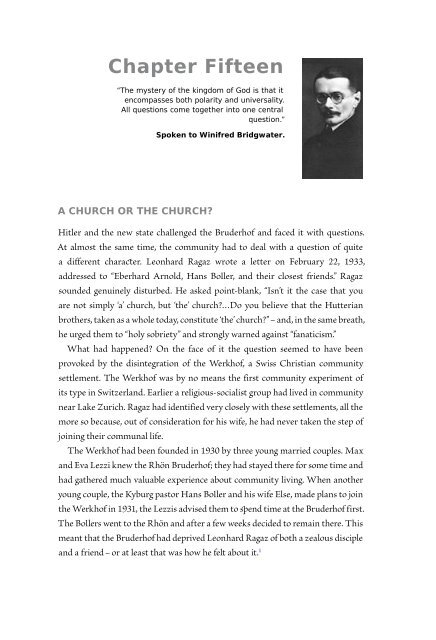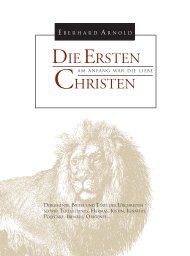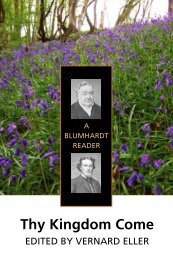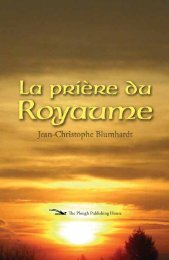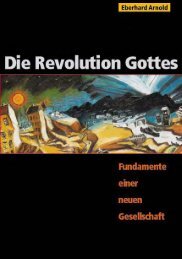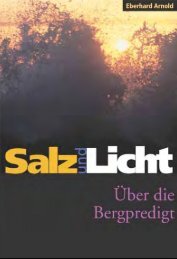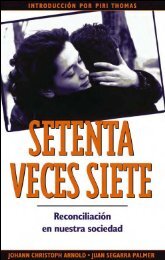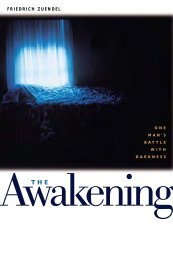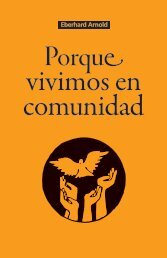- Page 2 and 3:
Against the WindE b E r h a r d a r
- Page 4 and 5:
ContentsContents—ivForeword—ixP
- Page 6 and 7:
Against the WindMapping Out Inner L
- Page 8 and 9:
Against the WindHomecoming—164Cha
- Page 10 and 11:
Against the WindSpirit has led them
- Page 12 and 13:
Against the WindWhen were his decis
- Page 14 and 15:
Against the WindThe family tree of
- Page 16 and 17:
Against the WindIn spite of her str
- Page 18 and 19:
Against the Windhe would not recogn
- Page 20 and 21:
Against the Windlife; it was an inn
- Page 22 and 23:
Against the Winda party…go out in
- Page 24 and 25:
Against the WindintroduCtion to thE
- Page 26 and 27:
Against the WindChapter twoFor soul
- Page 28 and 29:
Against the Windthat “the presenc
- Page 30 and 31:
Against the Windwith a student name
- Page 32 and 33:
Against the Windin the SCM executiv
- Page 34 and 35:
Against the WindJena and then, foll
- Page 36 and 37:
Against the WindCourtShip and Engag
- Page 38 and 39:
Against the Windher up to date with
- Page 40 and 41:
Against the WindAugust 6: Eberhard
- Page 42 and 43:
Against the Windno other solution.
- Page 44 and 45:
Against the Windthem from entertain
- Page 46 and 47:
Against the Wind(it seems to me) th
- Page 48 and 49:
Against the Winda vocation as a fel
- Page 50 and 51:
Against the WindChapter four“The
- Page 52 and 53:
Against the WindBaptismOnce the pro
- Page 54 and 55:
Against the Windthe sermons that Sa
- Page 56 and 57:
Against the Windevening professors
- Page 58 and 59:
Against the WindThe point of Eberha
- Page 60 and 61:
Against the Windwith Emmy, who was
- Page 62 and 63:
Against the WindLeipzig-Lindenau an
- Page 64 and 65:
Against the WindDifficult matters a
- Page 66 and 67:
Against the WindEberhard still lack
- Page 68 and 69:
Against the Windsolved. Only the cr
- Page 70 and 71:
Against the Windordered by the doct
- Page 72 and 73:
Against the WindMoreover, the “im
- Page 74 and 75:
Against the Wind30, Germany on Augu
- Page 76 and 77:
Against the Windwar he had really h
- Page 78 and 79:
Against the Windcomfort that it fal
- Page 80 and 81:
Against the WindGerman in the Germa
- Page 82 and 83:
Against the WindhanS-hErmannMatters
- Page 84 and 85:
Against the Windconferences were ca
- Page 86 and 87:
Against the Windthis dreadful exper
- Page 88 and 89:
Against the WindChapter Seen“We m
- Page 90 and 91:
Against the Windparticipated in a W
- Page 92 and 93:
Against the Windlecture series, Ebe
- Page 94 and 95:
Against the Winddeclare unrelenting
- Page 96 and 97:
Against the Windfrom the compulsion
- Page 98 and 99:
Against the Windkingdom of God by c
- Page 100 and 101:
Against the Windand the old associa
- Page 102 and 103:
Against the Windcollecting subscrip
- Page 104 and 105:
Against the Windthat Emmy was on th
- Page 106 and 107:
Against the Windthe middle of Febru
- Page 108 and 109:
Against the Windand do what is good
- Page 110 and 111:
Against the Windheart in all the pr
- Page 112 and 113:
Against the WindKonrad Paul, had ma
- Page 114 and 115:
Against the WindVarious lists in Eb
- Page 116 and 117:
Against the Windmovement. Titles fo
- Page 118 and 119:
Against the Windat Sannerz celebrat
- Page 120 and 121:
Against the Windthe communal life,
- Page 122 and 123:
Against the WindAt the conference S
- Page 124 and 125:
Against the Windseemed unshaken. In
- Page 126 and 127:
Against the WindChapter tenThat pea
- Page 128 and 129:
Against the WindIn August of 1922 E
- Page 130 and 131:
Against the WindEberhard was no sup
- Page 132 and 133:
Against the WindthE fEllowShip of r
- Page 134 and 135:
Against the WindChildrEn’S Commun
- Page 136 and 137:
Against the Windformed openhearted
- Page 138 and 139:
Against the WindNordhausen and had
- Page 140 and 141: Against the WindgEmEindEGemeinde ta
- Page 142 and 143: Against the WindNeusonnefeld or vic
- Page 144 and 145: Against the WindBut Eberhard did no
- Page 146 and 147: Against the WindIt was a great help
- Page 148 and 149: Against the Windmanifesation ofG
- Page 150 and 151: Against the Windthe commitment made
- Page 152 and 153: Against the Wind‘ate their bread
- Page 154 and 155: Against the WindIf we really love c
- Page 156 and 157: Against the Windtwo smaller childre
- Page 158 and 159: Against the Windmeals. But Prince G
- Page 160 and 161: Against the Windwomen who found the
- Page 162 and 163: Against the Windon the eternal trut
- Page 164 and 165: Against the WindChapter thirteen“
- Page 166 and 167: Against the WindAfterwards he trave
- Page 168 and 169: Against the WindEberhard now confro
- Page 170 and 171: Against the Windhe went. To please
- Page 172 and 173: Against the Windfive and a half hou
- Page 174 and 175: Against the Windwith the Rhön Brud
- Page 176 and 177: Against the WindhomEComingAt long l
- Page 178 and 179: Against the WindChapter fourteen“
- Page 180 and 181: Against the WindHutterian tradition
- Page 182 and 183: Against the Windunity and peace is
- Page 184 and 185: Against the WindThis authority and
- Page 186 and 187: Against the Windseem all the more p
- Page 188 and 189: Against the WindSannerz days, who h
- Page 192 and 193: Against the WindAfter a period of i
- Page 194 and 195: Against the WindShocked silence.Ebe
- Page 196 and 197: Against the WindFriedmann told Raga
- Page 198 and 199: Against the WindEberhard fought aga
- Page 200 and 201: Against the WindThe only other poss
- Page 202 and 203: Against the Windbrothers and a few
- Page 204 and 205: Against the WindChapter Siteen“Wh
- Page 206 and 207: Against the WindStrugglE for unityT
- Page 208 and 209: Against the Windhome for the commun
- Page 210 and 211: Against the Windjourney also bore f
- Page 212 and 213: Against the WindParadoxically, in t
- Page 214 and 215: Against the WindThree days later, o
- Page 216 and 217: Against the Windtoo Early a dEath?E
- Page 218 and 219: Against the Windfinal quEStionSWhat
- Page 220 and 221: Against the Wind7The Moravian Breth
- Page 222 and 223: Against the Wind5From Eberhard’s
- Page 224 and 225: Against the Windgelist Heinrich Dal
- Page 226 and 227: Against the Wind11Balthasar Hubmaie
- Page 228 and 229: Against the Wind29“Repentance Day
- Page 230 and 231: Against the Wind26The periodical He
- Page 232 and 233: Against the Windorder, peace, and s
- Page 234 and 235: Against the Wind2German name: Gemei
- Page 236 and 237: Against the WindChaptEr ElEvEn1Wegw
- Page 238 and 239: Against the Wind9Among these reform
- Page 240 and 241:
Against the Wind22Diary entry for O
- Page 242 and 243:
Against the Windwith great accuracy
- Page 244 and 245:
Against the Wind1In 1933 about twen
- Page 246 and 247:
Time LinemaJor EvEntS in thE lifE o
- Page 248 and 249:
Against the Wind1927 May Arnolds an
- Page 250 and 251:
Select BibliographyArnold, Christop
- Page 252 and 253:
Against the WindGiese, Ernst. Und f
- Page 254 and 255:
IndexAAlm Bruderhof 189-190, 194-19
- Page 256:
Against the WindNeuwerk 89-90, 92-9


